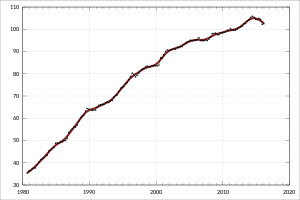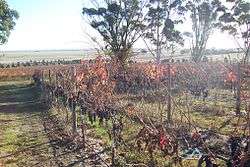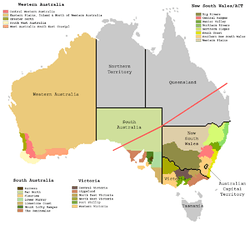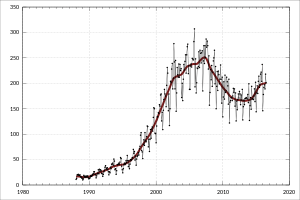Australian wine

The Australian wine industry is the world's fourth largest exporter of wine with approximately 750 million litres a year to the international export market with only about 40% of production consumed domestically.[1] The wine industry is a significant contributor to the Australian economy through production, employment, export and tourism.[2][3][4][5][6][7][8]
There is a A$2.8 billion domestic market for Australian wines, with Australians consuming over 530 million litres annually with a per capita consumption of about 30 litres – 50% white table wine, 35% red table wine.[9] Norfolk Islanders are the second biggest per capita wine consumers in the world with 54 litres.[10] Only 16.6% of wine sold domestically is imported.[1]
Wine is produced in every state, with more than 60 designated wine regions totalling approximately 160,000 hectares; however Australia's wine regions are mainly in the southern, cooler parts of the country, with vineyards located in South Australia, New South Wales, Victoria, Western Australia, Tasmania and Queensland. The wine regions in each of these states produce different wine varieties and styles that take advantage of the particular Terroir such as: climatic differences, topography and soil types. With the major varieties being predominantly Shiraz, Cabernet Sauvignon, Chardonnay, Merlot, Semillon, Pinot noir, Riesling, and Sauvignon blanc. Wines are often labelled with the name of their grape variety, which must constitute at least 85 percent of the wine.
History


Vine cuttings from the Cape of Good Hope were brought to the penal colony of New South Wales by Governor Phillip on the First Fleet (1788).[11] An attempt at wine making from these first vines failed, but with perseverance, other settlers managed to successfully cultivate vines for winemaking, and Australian made wine was available for sale domestically by the 1820s.[12] In 1822 Gregory Blaxland became the first person to export Australian wine, and was the first winemaker to win an overseas award.[13] In 1830 vineyards were established in the Hunter Valley.[11] In 1833 James Busby returned from France and Spain with a serious selection of grape varieties including most classic French grapes and a good selection of grapes for fortified wine production.[11] Wine from the Adelaide Hills was sent to Queen Victoria in 1844, but there is no evidence that she placed an order as a result. The production and quality of Australian wine was much improved by the arrival of free settlers from various parts of Europe, who used their skills and knowledge to establish some of Australia's premier wine regions. For example, emigrants from Prussia in the mid-1850s were important in establishing South Australia's Barossa Valley as a winemaking region. In smaller scale, winemakers from Swiss also helped in establishing Geelong wine region in Victoria in 1842.
Early Australian winemakers faced many difficulties, particularly due to the unfamiliar Australian climate. However they eventually achieved considerable success. "At the 1873 Vienna Exhibition the French judges, tasting blind, praised some wines from Victoria, but withdrew in protest when the provenance of the wine was revealed, on the grounds that wines of that quality must clearly be French."[14] Australian wines continued to win high honours in French competitions. A Victorian Syrah (also called Shiraz) competing in the 1878 Paris Exhibition was likened to Château Margaux and "its taste completed its trinity of perfection."[14] One Australian wine won a gold medal "first class" at the 1882 Bordeaux International Exhibition and another won a gold medal "against the world" at the 1889 Paris International Exhibition.[14] That was all before the destructive effects on the industry of the phylloxera epidemic.
Until the late 1970s, Australian wine production consisted largely, but not exclusively, of sweet and fortified wines. Since then, Australia has rapidly become a world leader in both the quantity and quality of wines it produces. For example, Australian wine exports to the US rose from 578,000 cases in 1990 to 20,000,000 cases in 2004 and in 2000 it exported more wine than France to the UK for the first time in history.
The industry has at times suffered from its own productivity. In the late 1980s, governments sponsored growers to pull out their vines to overcome a glut of winegrapes. Low grape prices in 2005 and 2006 have led to calls for another sponsored vine pull.[15] Cleanskin wines were introduced into Australia during the 1960s as a means to combat oversupply and poor sales.
In recent years organic and biodynamic wines have been increasing in popularity, following a worldwide trend. In 2004 Australia hosted the First International Biodynamic Wine Forum in Beechworth, Victoria which brought together biodynamic wine producers from around the globe. Despite the overproduction of grapes many organic and biodynamic growers have enjoyed continuing demand thanks to the premium prices winemakers can charge for their organic and biodynamic products, particularly in the European market.
Grape varieties
Major grape varieties are Shiraz, Cabernet Sauvignon,[16] Merlot, Chardonnay,[16] Sauvignon blanc, Sémillon, and Riesling. The country has no native grapes, and Vitis vinifera varieties were introduced from Europe and South Africa in the late 18th and early 19th centuries. Some varieties have been bred by Australian viticulturists, for example Cienna and Tarrango.
Although Syrah was originally called Shiraz in Australia and Syrah elsewhere, its dramatic commercial success has led many Syrah producers around the world to label their wine "Shiraz".
About 130 different grape varieties are used by commercial winemakers in Australia. Over recent years many winemakers have begun exploring so called "alternative varieties" other than those listed above. Many varieties from France, Italy and Spain for example Petit Verdot, Pinot grigio, Pinot noir, Sangiovese, Tempranillo and Viognier are becoming more common. Wines from many other varieties are being produced.
Australian winemaking results have been impressive and it has established benchmarks for a number of varietals, such as Chardonnay and Shiraz. Moreover, Australians have innovated in canopy management and other viticultural and in wine-making techniques, and they have a general attitude toward their work that sets them apart from producers in Europe. Australian wine-makers travel the wine world as highly skilled seasonal workers, relocating to the northern hemisphere during the off-season at home. They are an important resource in the globalisation of wine and wine critic Matt Kramer notes that "the most powerful influence in wine today" comes from Australia.
| Grape | Area Ha (04)[17] | Area Ha (05)[17] | Area Ha (06)[18] | Area Ha (07)[17] | Area Ha (08)[17] |
|---|---|---|---|---|---|
| Shiraz | 39,182 | 40,508 | 41,115 | 43,417 | 43,977 |
| Cabernet Sauvignon | 29,313 | 28,621 | 28,103 | 27,909 | 27,553 |
| Merlot | 10,804 | 10,816 | 10,593 | 10,790 | 10,764 |
| Pinot noir | 4,424 | 4,231 | 4,254 | 4,393 | 4,490 |
| Grenache | 2,292 | 2,097 | 2,025 | 2,011 | 2,011 |
| Mourvedre | 1,040 | 963 | 875 | 794 | 785 |
| Other Red | 11,235 | 10,797 | 7,002 | 11,309 | 10,902 |
| Grape | Area Ha (04)[17] | Area Ha (05)[17] | Area Ha (06)[18] | Area Ha (07)[17] | Area Ha (08)[17] |
|---|---|---|---|---|---|
| Chardonnay | 28,008 | 30,507 | 31,219 | 32,151 | 31,564 |
| Sémillon | 6,278 | 6,282 | 6,236 | 6,752 | 6,716 |
| Sauvignon blanc | 3,425 | 4,152 | 4,661 | 5,545 | 6,404 |
| Riesling | 4,255 | 4,326 | 4,400 | 4,432 | 4,400 |
| Other White | 23,925 | 23,365 | 17,683 | 24,303 | 23,109 |
GSM blends
GSM is a name commonly used for a red wine consisting of a blend of Grenache, Shiraz (Syrah), and Mourvèdre.[19] This blend originated from those used in some Southern Rhône wines, including Châteauneuf-du-Pape. Grenache is the lightest of the three grapes, producing a pale red juice with soft berry scents and a bit of spiciness. As a blending component, it contributes alcohol, warmth and fruitiness without added tannins. Shiraz can contribute full-bodied, fleshy flavours of black fruits and pepper. It adds color, backbone and tannins and provides the sense of balance such blends require. Mourvèdre contributes elegance, structure and acidity to the blend, producing flavours of sweet plums, roasted game and hints of tobacco.[20]
Production

Australia's most famous wine is Penfolds Grange. The great 1955 vintage was submitted to competitions beginning in 1962 and over the years has won more than 50 gold medals. The vintage of 1971 won first prize in Syrah/Shiraz at the Wine Olympics in Paris. The 1990 vintage was named 'Red Wine of the Year' by the Wine Spectator magazine in 1995, which later rated the 1998 vintage 99 points out of a possible 100. Wine critic Hugh Johnson has called Grange the only First Growth of the Southern Hemisphere. The influential wine critic Robert Parker, who is well known for his love of Bordeaux wines, has written that Grange "has replaced Bordeaux's Pétrus as the world's most exotic and concentrated wine".[21] Other red wines to garner international attention include Henschke Hill of Grace,[22][23][24] Clarendon Hills Astralis,[22][23][24] D'Arenberg Dead Arm,[22][23][24] Torbreck Run Rig[22][23][24] and other high-end Penfolds wines such as St Henri shiraz.[22][23][24]
Australia has almost 2000 wine producers, most of whom are small winery operations. The market is dominated by a small number of major wine companies. After several phases of consolidation, the largest Australian wine company by sales of branded wine was Treasury Wine Estates in 2001–2003 and then in 2004 and 2005, Hardy Wine Company. Hardys, as part of the world's biggest wine company Constellation Brands, had the largest vineyard area and the largest winegrape intake in the years 2001 – 2005.[25]
Major wine regions

The information included on wine labels is strictly regulated. One aspect of this is that the label must not make any false or misleading statements about the source of the grapes. Many names (called geographic indications) are protected. These are divided into "South Eastern Australia", the state names, zones (shown in the map), regions, and subregions.[26] The largest volume of wine is produced from grapes grown in the warm climate Murray-Darling Basin zones of Lower Murray, North Western Victoria and Big Rivers. In general, the higher-value premium wines are made from smaller and cooler-climate regions.
The South Australian wine industry is responsible for most of the production of wine in Australia.[27] In recent years, the Tasmanian wine industry has emerged as a producer of high quality wines. In particular, the Tamar Valley has developed a reputation for its Chardonnay and Pinot noir, which are well suited to the cooler Tasmanian climate. Queensland is also developing a wine industry with over 100 vineyards registered in the state. Some notable wines are produced in the high-altitude Granite Belt region in the state's extreme south, production is centred on the towns of Stanthorpe and Ballandean.

Some well-known wine-producing regions include:
- Alpine Valleys
- Beechworth
- Goulburn Valley
- Grampians
- Heathcote wine region
- Henty
- Mornington Peninsula
- Pyrenees
- Rutherglen
- Strathbogie Wine Region
- Yarra Valley
- King Valley
- Hunter Valley
- Mudgee
- Orange
- Riverina
- New England
- Southern Highlands
- Shoalhaven Coast
Greater Perth:
- Perth Hills
- Peel
- Swan Valley
South Western Australia:
- Blackwood Valley
- Geographe
- Manjimup
- Margaret River
- Pemberton
- Tamar Valley
- Derwent Valley
- Huon Valley / Channel
- Coal River
- Pipers River
- East Coast
- North West
Export markets

The Australian Wine export market was worth 2.8 billion Australian dollars (A$) a year in June 2007, having grown at 9%pa.[30] Of this about A$2 billion is accounted for by North America and the UK, and in this key latter market Australia is now the largest supplier of still wines. 2007 statistics for the North American market show that Australian wine accounted for a 17% share of the total value of US imported wine, behind France with 31% and Italy with 28%.[31]
New marketing strategies developed for the key UK market encouraged customers to explore premium Australian brands, while maintaining sales of the lower-margin high-volume brands, following research that indicated a celebratory dinner was more likely to be accompanied by an inferior French wine than a premium Australian wine.[32] This is partly due to exchange rate fluctuations, making Australian wines appear much cheaper than French wines in the UK and hence perceived as being of poorer quality. While this situation may be somewhat mitigated by the continued rise in the Australian dollar during 2010, the stronger currency threatens to weaken Australian exports to the crucial US market.
Australian wine accounts for a very large imported wine market share in South Asian countries and is the second largest imported wine in India with a market share of 16%.[33]
See also
- Agriculture in Australia
- National Wine Centre of Australia
- Australian Wine Research Institute
- Australian Society of Viticulture and Oenology
- Australian Wine Critic Huon Hooke
- Australian and New Zealand Wine Industry Journal
- Good Food & Wine Show
- Langton's Classification of Australian Wine
- Australian Wine and Brandy Corporation
- Australia's First Families of Wine
References
Notes
- 1 2 "1329.0 – Australian Wine and Grape Industry, 2010–2011". abs.gov.au. Australian Bureau of Statistics. 27 February 2012. Retrieved 22 May 2012.
- ↑ International Organization of Wine and Vine (24 June 2002). "Situation of the world viticultural sector in 2006". Winebiz.com.au. Archived from the original on 18 August 2010. Retrieved 6 September 2010.
- ↑ "Australian Wine Industry Statistics". Winebiz.com.au. Retrieved 22 October 2010.
- ↑ Ed, McCarthy; Ewing-Mulligan, Mary (2006). Wine For Dummies. For Dummies. ISBN 0-470-04579-5.
- ↑ Stevenson, Tom (2005), The Sotheby's Wine Encyclopedia (4th ed.), Dorling Kindersley, ISBN 0-7566-1324-8
- ↑ "Wine Australia". wineaustralia.com. Archived from the original on 23 October 2010. Retrieved 22 October 2010.
- ↑ Johnson, Hugh; Robinson, Jancis (2007). The World Atlas of Wine (6th ed.). Mitchell Beazley. ISBN 978-1-84533-414-7.
- ↑ Clarke, Oz (2002). Oz Clarke's New Wine Atlas: Wines and Wine Regions of the World (6th ed.). Harcourt. ISBN 978-0151009138.
- ↑ "4307.0.55.001 – Apparent Consumption of Alcohol, Australia, 2010–11". abs.gov.au. Australian Bureau of Statistics. 3 May 2012. Retrieved 20 May 2012.
- ↑ "Per Capita Wine Consumption by Country – Ranked by Per Capita Consumption 2007–2010" (PDF). Table 7.1. The Wine Institute – Trade Data And Analysis. Retrieved 22 May 2012.
- 1 2 3 Clark, Oz (2004). Australian Wine Companion. Time Warner Book Group UK. p. s.12. ISBN 0-316-72874-8.
- ↑ Hartley, Clive, The Australian Wine Guide, Hospitality Books, NSW 2002
- ↑ Walsh, Gerald (1979). "The Wine Industry of Australia 1788 1979". Wine Talk. [A.N.U. Canberra]. Archived from the original on 28 August 2006. Retrieved 8 September 2006.
- 1 2 3 Phillips, Roderick (2000). A short history of wine. London: Allen Lane. p. 265. ISBN 0-7139-9432-0.
- ↑ Haxton, Nance (5 June 2006). "Grape glut: call for subsidised vine pull". PM. Australian Broadcasting Corporation. Retrieved 27 August 2006.
- 1 2 Walton, Stuart (2005). Cook's Encyclopedia of Wine. Anness Publishing Limited 2002, 2005. pp. s.232, 233. ISBN 0-7607-4220-0.
- 1 2 3 4 5 6 7 8 Halliday, James. Australian Wine Companion (2010 ed.). ISBN 978-1-74066-754-8.
- 1 2 Halliday, James (2008). Australian Wine Companion. Hardie Grant Books. p. 45. ISBN 978-1-74066-515-5.
- ↑ J. Robinson (ed) "The Oxford Companion to Wine" Third Edition pg 297–298, 333–334 Oxford University Press 2006 ISBN 0-19-860990-6
- ↑ Robinson, Jancis Vines, Grapes & Wines Mitchell Beazley 1986 ISBN 1-85732-999-6
- ↑ The Economist (16 December 1999 ). The globe in a glass
- 1 2 3 4 5 Langton’s Classification of Australian Wine
- 1 2 3 4 5 Langton's Classification of Australian Wine IV, Jancis Robinson
- 1 2 3 4 5 Appellation Australia, An exploration of Australian wine
- ↑ News & Information for the Australian Wine Industry
- ↑ "Register of Protected Names (includes textual descriptions of Australia's GIs)". Australian Wine and Brandy Corporation. 2003. Archived from the original on 19 August 2006. Retrieved 5 September 2006.
- ↑ "South Australia". Wine Australia. Retrieved 24 June 2011.
- ↑ "Western Australia's Wine Regions". Wine Australia. Retrieved 25 November 2010.
- ↑ http://winetasmania.com.au/wine_trails
- ↑ The Australian Wine and Brandy Corporation Wine Export Approval Report Excerpts
- ↑ U.S. Department of Commerce "U.S. Wine Industry – 2008" (PDF). (37.8 KB)
- ↑ Winemakers' Federation of Australia Strategy (May 2007), "Wine Australia: Directions to 2025" (PDF). (355 KB)
- ↑ "Wine Industry India". Imagin Mor Pty Ltd.
Bibliography
- The globe in a glass. The Economist (London), 16 December 1999 .
- Clarke, Oz (2004). Oz Clarke's Australian Wine Companion: An essential guide for all lovers of Australian wine. London: Websters/Time Warner Books UK. ISBN 0316728748.
- Forrestal, Peter, ed. (1999). Discover Australia: Wineries. Milsons Point, NSW: Random House Australia. ISBN 0091837898.
- Halliday, James (1985). The Australian Wine Compendium. North Ryde, NSW: Angus & Robertson. ISBN 0207151377.
- Halliday, James (1994). A history of the Australian wine industry 1949–1994 Adelaide: Australian Wine and Brandy Corporation in association with Winetitles .ISBN 1875130160
- Halliday, James (2008). James Halliday's Wine Atlas of Australia (rev. ed.). Prahran, Vic: Hardie Grant Books. ISBN 9781740666855.
- Kramer, Matt. Making Sense of Wine. Philadelphia: Running Pres, 2003.
- McCarthy, Ed, and Ewing-Mulligan, Mary. Wine for Dummies: A Reference for the Rest of Us. Foster City, CA: IDG Books, 1995.
- Palmer, Margot. Australian Wine. An Export Success Story (Sydney), December 2007.
- Simon, André Louis (1966). The Wines Vineyards and Vignerons of Australia. London: Paul Hamlyn. OCLC 52512515.
- Phillips, Rod. A Short History of Wine. NY: HarperCollins, 2000.
- Zraly, Kevin. Windows of the World Complete Wine Course. NY: Sterling, 2005.